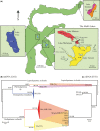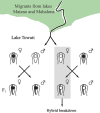Speciation patterns and processes in the zooplankton of the ancient lakes of Sulawesi Island, Indonesia
- PMID: 24101996
- PMCID: PMC3790553
- DOI: 10.1002/ece3.697
Speciation patterns and processes in the zooplankton of the ancient lakes of Sulawesi Island, Indonesia
Abstract
Although studies of ancient lake fauna have provided important insights about speciation patterns and processes of organisms in heterogeneous benthic environments, evolutionary forces responsible for speciation in the relatively homogenous planktonic environment remain largely unexplored. In this study, we investigate possible mechanisms of speciation in zooplankton using the freshwater diaptomids of the ancient lakes of Sulawesi, Indonesia, as a model system. We integrate phylogenetic and population genetic analyses of mitochondrial and nuclear genes with morphological and genome size data. Overall, our results support the conclusion that colonization order and local adaptation are dominant at the large, island scale, whereas at local and intralacustrine scales, speciation processes are regulated by gene flow among genetically differentiated and locally adapted populations. In the Malili lakes, the diaptomid populations are homogenous at nuclear loci, but show two highly divergent mitochondrial clades that are geographically restricted to single lakes despite the interconnectivity of the lake systems. Our study, based on coalescent simulations and population genetic analyses, indicates that unidirectional hybridization allows gene flow across the nuclear genome, but prevents the introgression of mitochondria into downstream populations. We suggest that hybridization and introgression between young lineages is a significant evolutionary force in freshwater plankton.
Keywords: Ancient lakes; Malili lakes; copepoda; plankton; population structure.
Figures



Similar articles
-
Age estimates for an adaptive lake fish radiation, its mitochondrial introgression, and an unexpected sister group: Sailfin silversides of the Malili Lakes system in Sulawesi.BMC Evol Biol. 2014 May 3;14:94. doi: 10.1186/1471-2148-14-94. BMC Evol Biol. 2014. PMID: 24886257 Free PMC article.
-
The ancient lakes of Indonesia: towards integrated research on speciation.Integr Comp Biol. 2011 Oct;51(4):634-43. doi: 10.1093/icb/icr101. Epub 2011 Aug 19. Integr Comp Biol. 2011. PMID: 21856735 Review.
-
Species divergence and repeated ancient hybridization in a Sulawesian lake system.J Evol Biol. 2021 Nov;34(11):1767-1780. doi: 10.1111/jeb.13932. Epub 2021 Sep 24. J Evol Biol. 2021. PMID: 34532915
-
Ancient lakes revisited: from the ecology to the genetics of speciation.Mol Ecol. 2010 Nov;19(22):4837-51. doi: 10.1111/j.1365-294X.2010.04832.x. Epub 2010 Sep 27. Mol Ecol. 2010. PMID: 20874762 Review.
-
Adaptive radiation and ecological diversification of Sulawesi's ancient lake shrimps.Evolution. 2010 Nov;64(11):3287-99. doi: 10.1111/j.1558-5646.2010.01043.x. Evolution. 2010. PMID: 20500216
Cited by
-
Adaptive Introgression as an Evolutionary Force: A Meta-Analysis of Knowledge Trends.Evol Appl. 2025 Jun 20;18(6):e70103. doi: 10.1111/eva.70103. eCollection 2025 Jun. Evol Appl. 2025. PMID: 40548230 Free PMC article.
-
From local adaptation to ecological speciation in copepod populations from neighboring lakes.PLoS One. 2015 Apr 27;10(4):e0125524. doi: 10.1371/journal.pone.0125524. eCollection 2015. PLoS One. 2015. PMID: 25915059 Free PMC article.
-
Cryptic diversity and speciation in an endemic copepod crustacean Harpacticella inopinata within Lake Baikal.Ecol Evol. 2024 May 31;14(6):e11471. doi: 10.1002/ece3.11471. eCollection 2024 Jun. Ecol Evol. 2024. PMID: 38826165 Free PMC article.
References
-
- Abbott MB, Binford MW, Brenner M, Kelts KR. A 3500 14C yr high-resolution record of water-level changes in Lake Titicaca, Bolivia/Peru. Quatern. Res. 1997;47:169–180.
-
- Adamowicz J, Menu-Marque S, Hebert PDN, Purvis A. Molecular systematics and patterns of morphological evolution in the Centropagidae (Copepoda: Calanoida) of Argentina. Biol. J. Linn. Soc. 2007;90:279–292.
-
- Ballard JWO, Whitlock MC. The incomplete natural history of mitochondria. Mol. Ecol. 2004;13:729–744. - PubMed
-
- Bell MA, Travis MP. Hybridization, transgressive segregation, genetic covariation, and adaptive radiation. Trends Ecol. Evol. 2005;20:358–361. - PubMed
-
- Boileau MG, Hebert PDN. Genetic consequences of passive dispersal in pond-dwelling copepods. Evolution. 1991;45:721–733. - PubMed
LinkOut - more resources
Full Text Sources
Other Literature Sources

